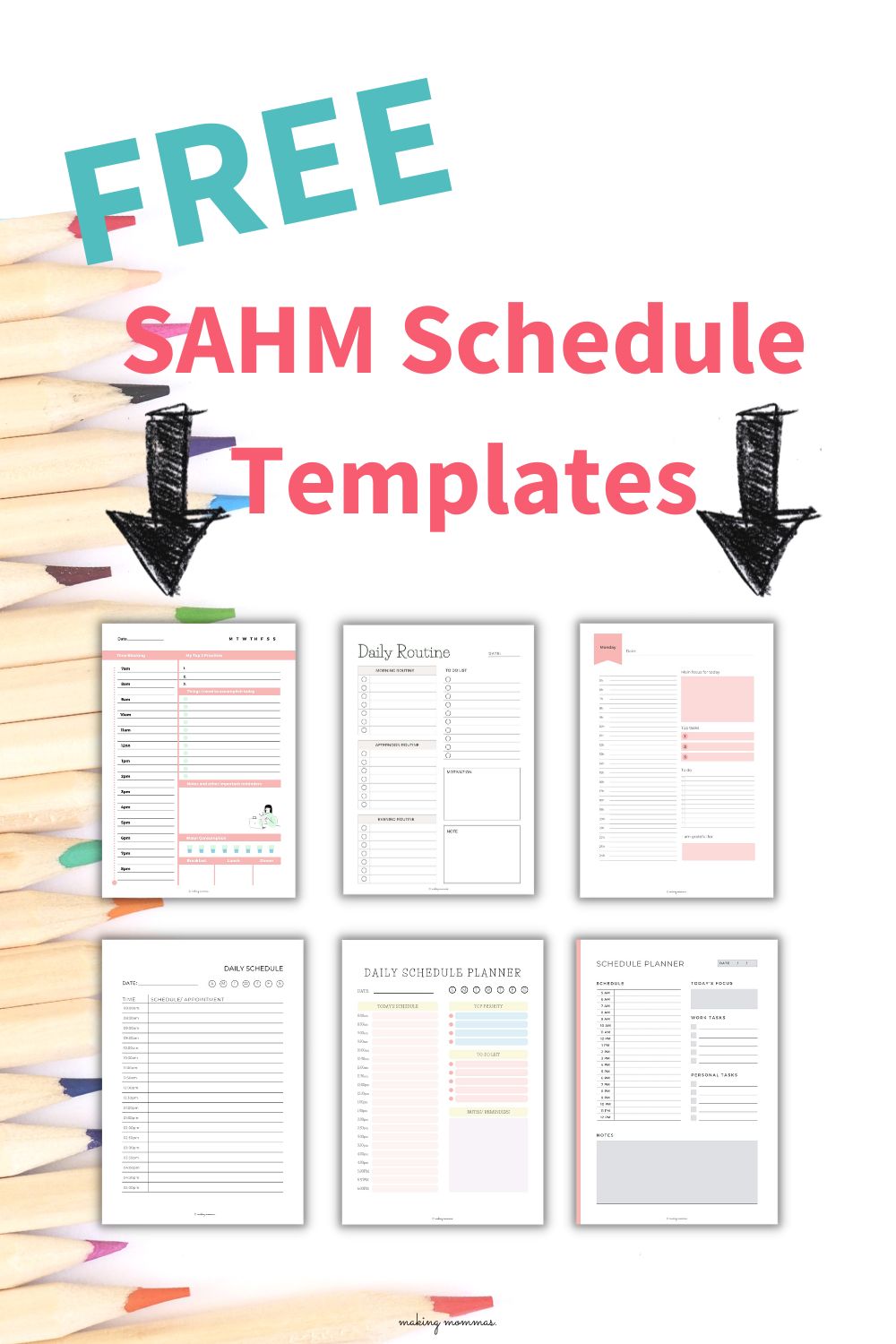In this article:
ToggleMastering scheduling is crucial for busy stay-at-home moms. This guide is packed with effective techniques to help you balance your kids’ needs, household chores, and personal time, boosting your productivity.

Being a stay-at-home mom is no easy task! It’s a never-ending whirlwind of managing the household, raising kids, and trying to find time for yourself.
We’ve all been there – feeling exhausted and burnt out. It’s like there’s never enough time in the day to get everything done.
But what if there was a way to bring balance and order to your daily routine? That’s where the art of scheduling comes in.
In this guide, I want to share some practical tips and techniques that have worked for me as a stay-at-home mom. Trust me, I’ve been through it all.
From juggling tasks to finding time for myself, I’ve learned a thing or two along the way. And now, I want to pass on that knowledge to you.
By mastering the art of scheduling, you’ll be able to manage your time more effectively and find that much-needed balance. You’ll be able to meet your children’s needs, take care of household tasks, and still have time for yourself.
Say goodbye to stress and hello to a more productive and balanced lifestyle!
So, if you’re ready to take control of your schedule and create a life that works for you, let’s dive in!! I’ll be here every step of the way to guide and support you.
You’ve got this!
Time Blocking Method

Time blocking is a super effective scheduling technique that involves assigning specific time slots to specific tasks or activities throughout your day.
It’s a game-changer, especially for stay-at-home moms, as it helps you juggle multiple responsibilities efficiently.
From taking care of your children to running the household, and even finding some ‘me’ time, time blocking ensures that each aspect of your day gets the attention it deserves.
So, here’s how you can make time blocking work for you:
- Identify Your Tasks: Make a list of all the things you need to do in a day, including your children’s routines, household chores, and personal activities.
- Estimate Time for Each Task: Take a guess at how long each task will take. Don’t worry if it’s not precise, you’ll get better at it with practice.
- Create Your Time Blocks: Divide your day into blocks of time and assign specific tasks or sets of tasks to each block. For example, you can block out 7 AM to 8 AM for getting the kids ready for school.
- Stick to Your Schedule: The key is to stick to your schedule as much as possible. Try your best to start and finish each task within its allotted time block.
- Be Flexible: Some days may not go as planned, and that’s okay. Adjust your time blocks as needed, but try to maintain the principle of dedicating specific times for specific tasks.
Remember, time blocking is all about creating a schedule that works for you and your family. Feel free to experiment and adjust your blocks until you find the rhythm that suits you best.
Time Chunking Method

Time chunking is a super effective time management strategy that can really benefit stay-at-home moms as well.
It’s all about dedicating specific chunks, or blocks of time, to tackle similar tasks. This way, you avoid that mental fatigue that comes from constantly jumping between different activities and you can focus more deeply on each task.
And if you work from home, time chunking is a total game-changer.
It’s all about finding that perfect balance between your professional tasks and your parental responsibilities. By grouping similar tasks together, such as returning calls and checking emails, outlining and writing blog posts, and household chores and running errands, you’re making the most of your mental energy and concentration, which makes your day way more efficient.
The perks of time chunking are seriously awesome. It streamlines your day, boosts productivity, and helps you beat that overwhelming stress.
Trust me, it’s a great way to avoid that mental fatigue that comes from constantly switching gears. And the best part?
This method is super flexible, so it can easily accommodate those unexpected interruptions that are oh-so-common in a household with kids.
Here’s a step-by-step guide on how to rock time chunking:
- Group Similar Tasks: Start by identifying tasks that are similar or require a similar mindset. Think household chores, taking care of the kiddos, or even some me-time.
- Allocate Time Chunks: Now, decide how long you want to dedicate to each group of tasks. Could be an hour, a couple of hours, or even half a day, depending on what you’re working with.
- Schedule Your Chunks: Assign specific time chunks to each group of tasks. For example, you could set aside some time in the morning for household chores and another chunk in the afternoon for fun activities with your little ones.
- Focus on One Chunk at a Time: When you’re in a time chunk, give your full attention to the tasks within that chunk. Try not to get ahead of yourself and jump to tasks in the next chunk.
- Adjust as Needed: Remember, the goal is to create a schedule that works for you. If a particular time chunk isn’t working out, feel free to tweak it until you find that perfect balance that suits your needs.
Just like time blocking, time chunking takes practice and patience. But trust me, once you get the hang of it, it’ll seriously level up your productivity game and make your life so much easier. You got this!
Batching Tasks

Batching tasks is a super effective productivity method that goes hand-in-hand with time chunking. The idea is to tackle similar tasks in a specific batch, which helps minimize distractions and boost productivity.
This approach not only saves time but also keeps the quality of work in check. For example, you could batch all your laundry tasks into one chunk of time or group meal preparation tasks together.
The key is to stay in the same mindset for a while, reducing the mental strain of switching tasks. Just remember, consistency is key, and finding the approach that works best for you is crucial in mastering task batching.
Here’s how to do it:
- Identify Similar Tasks: Review your to-do list and identify tasks that are similar or require the same resources. This could be anything from responding to emails, doing household chores, or creating content for social media.
- Group Tasks Together: Once you’ve identified similar tasks, group them together. These groups are your ‘batches’. For example, you might have a batch for admin tasks like email responses and scheduling appointments, and another batch for creative tasks like content creation or brainstorming.
- Assign Time Slots to Each Batch: Allocate specific time slots in your day for each batch. Try to assign these time slots based on your energy levels throughout the day. For instance, if you find you’re more creative in the morning, assign your creative batch to the AM hours.
- Work on One Batch at a Time: During each time slot, focus solely on the tasks within your current batch. This will help improve your concentration and productivity, as your brain isn’t constantly switching between different types of tasks.
- Evaluate and Adjust: After a few days or weeks, evaluate the effectiveness of your task batching system. If you find certain batches are taking longer than expected or your energy levels don’t match up with your batches, adjust your schedule accordingly. Remember, the goal of task batching is to increase productivity, so don’t be afraid to modify your approach to better suit your needs.
By following these steps, you’ll be well on your way to creating an efficient task-batching system that boosts your productivity and reduces mental fatigue.
My Five Block System

My five block system is a pretty cool way to manage your time and be more productive, especially if you’re a stay-at-home mom. It is literally what I used for the past few years, to get my freelancing career up and off the ground!
The first block is the Pre-Morning Routine Block. This is the time when you first wake up, before the kids and the chaos of the day begins.
It’s perfect for some self-care and personal growth activities, like meditation or reading. Or you can use this time to get your most important items checked off of your to-do list.
For example, I am using this pre-morning block to write this blog post for you!
After the pre-morning block, we move on to the Morning Routine Block. This is when you get the household up and running, make breakfast, get the kids ready for school, and set the tone for the day.
Next is the Work Time Block. This is your chance to focus on your tasks, whether it’s remote work, personal projects, or tackling household chores, if you don’t work from home.
I always set aside time for the work block when the kids were either not home or were occupied in other activities, so that I wouldn’t be interrupted.
After work time, you’ve got the Afternoon Routine Block. This is the transitional part of the day, where you might be picking up the kids from school or shifting into a slower pace.
You might have an afternoon routine here, or a meal time scheduled in.
And finally, we’ve got the Evening Routine Block. This is when you wind down, have dinner, get ready for bed, and enjoy some relaxing activities with your family, like reading or just spending quality time together.
By following this system, you’ll bring structure and balance to your day, making you more productive and giving you that much-needed peace of mind. It totally worked for me!
Here’s how to get started:
- Identify your five blocks: Take a look at your daily routine and designate the five blocks that work best for you. Make sure each block has a clear start and end time.
- Assign tasks to each block: Once you’ve got your blocks set, it’s time to assign tasks to each one. Remember, it’s not about cramming as much as you can into each block, but about being smart with your time and priorities.
- Implement and adjust: Start following your new routine. It might take a little while to get used to it, but be patient. And if something doesn’t seem to be working, feel free to make adjustments. Flexibility is key!
So there you have it. With the Five Block System, you’ll bring structure and balance to your day, making the most of your time and finding tranquility in the midst of all the busyness that comes with motherhood.
Give it a try and see how it works for you!
“Eating Your Frogs”

“Eating your frogs” is a productivity strategy that encourages you to tackle your most daunting tasks first, usually at the start of the day. The term was inspired by a quote often attributed to Mark Twain: “Eat a live frog first thing in the morning and nothing worse will happen to you the rest of the day.”
For stay-at-home moms, “eating your frogs” can be particularly beneficial. With countless tasks vying for your attention, starting your day by accomplishing the most challenging ones can give you a sense of achievement and relief.
It allows you to focus better on subsequent tasks and reduces the stress of having a difficult task hanging over your head all day.
Here’s a step-by-step process to implement “eating your frogs” in your routine:
- Identify your “frogs” – the tasks that are most challenging or those you’re likely to procrastinate on.
- Prioritize these tasks to be done as early in the day as possible.
- Ideally, schedule them in your first routine block.
- Remember, it’s not about rushing through them, but giving them your undivided attention and effort.
- Practice focusing on these tasks and completing them with dedication.
- Over time, you’ll find that “eating your frogs” significantly boosts your productivity.
- As a result, your day-to-day tasks will seem less overwhelming.
I absolutely hate pitching. But I knew I needed to do it, in order to land a couple more clients.
So, I ate that frog first thing in the morning – in my pre-morning block!
Follow these steps to make “eating your frogs” a productive habit in your routine.
Routine vs Schedule

When it comes to organizing your day, routines and schedules both have their benefits.
A routine is all about regular activities and habits that you do in the same order consistently. For example, your morning routine might involve waking up, exercising, having breakfast, and then tackling the day’s tasks.
Routines provide structure, reduce decision-making, and offer flexibility.
On the other hand, a schedule is more rigid and time-bound. It’s all about allocating specific time slots for tasks or activities throughout the day.
For instance, you might schedule doing laundry from 10 am to 11 am, followed by cleaning from 11 am to 12 pm. Schedules boost productivity by giving each task a designated time, but they can feel a bit restrictive.
As a stay-at-home mom, both routines and schedules can be helpful.
Routines offer a reliable structure that can be comforting for you and your children. They reduce the need for constant decision-making and can adapt to changing needs.
However, without a strict timeline, tasks might take longer than expected and some could get neglected.
A schedule, while more rigid, provides a clear timeline and ensures all tasks are completed. It eliminates wasted time and improves efficiency.
However, it may feel constraining and doesn’t always account for unexpected interruptions, which are quite common with children.
Choosing between a routine and a schedule depends on your personal preference and family needs.
If you thrive on consistency without strict time limitations, a routine might be more suitable. However, if you find that specific tasks are being neglected or you’re constantly running out of time, a schedule might be a better choice.
I personally use both. I like a routine, and that is how I structure my day. But I have noticed that my tasks always take longer than I expected, and I end up running out of time.
So now I’m time blocking my work tasks within my Work Block. This way, I get a better picture of what I can realistically get done in a day, and don’t freak out as much if I can’t get everything done.
Remember, balance is key! A combination of routine for daily tasks and a schedule for specific, time-bound tasks could be the optimal way to manage your day.
Building Your Own Stay at Home Mom Schedule

Before we talk about how to build your own stay at home mom schedule, let’s look at how it’s worked for other Sahms.
Let’s take the case of Sarah, a stay-at-home mom of three kids aged 6, 4, and 2. Her days were always a whirlwind, with tasks constantly slipping through the cracks.
So, Sarah decided to give her day a little more structure by trying out a mix of routine and scheduling.
First things first, she established a morning routine. You know, the usual drill – wake up, make beds, breakfast, and some light cleaning. This simple routine gave her a consistent start to the day, setting a positive tone for the rest of her day.
But Sarah didn’t stop there. She also used a schedule to manage her kids’ homeschooling and her own work time. She set specific hours for each homeschooling session, making sure her kids had a structured learning environment.
And for her own work tasks, she tried time-blocking within her Work Block. Turns out, tasks always took longer than expected, so this helped her stay on top of things and realistically plan her workload.
Now, let me tell you, this combination worked like a charm for Sarah. The routine gave her day a steady rhythm without being too rigid, while the schedule made sure she never missed any important tasks.
Sarah’s evenings followed a similar pattern of structure and flexibility. After a dinner mostly prepared in the afternoon during the kid’s nap time, she cleaned up, while dad took the kids downstairs to play.
The evening was also the time for some bonding; they would either play a board game, watch a movie, or read together.
Finally, Sarah implemented a bedtime routine for the kids which included brushing teeth, changing into pajamas, and a bedtime story. This routine helped signal to the kids that it was time to wind down for the night.
Throughout the evening, Sarah found that this mix of structured routines and scheduled activities helped maintain harmony in the household and ensured that she could end her day on a positive note.
That’s what worked for Sarah. Now let’s find what works for you!
When it comes to finding what works best for you and your family, here are a few tips:
- Give both routines and schedules a shot for a reasonable period of time to see what works for you.
- Stay flexible. Understand that what works like magic one day might flop the next, so give each technique a fair chance.
- Don’t forget to leave room for relaxation and spontaneous activities in your routine or schedule, ensuring a balanced approach.
- And most importantly, listen to your family’s needs and adjust your methods accordingly. Remember, the goal is to create a more peaceful and productive home environment through consistent experimentation and adaptation.
Hope these tips help you find your groove!
At the End of the Day…

At the end of the day, what really matters is creating a home filled with understanding, harmony, and love.
Routines and schedules can bring structure and peace, but they’re just tools to help you navigate the complexities of family life.
Remember, every family is unique, and what works for one may not work for another. It’s all about finding what suits your family’s rhythm and pace.
Because in the end, it’s not about having a perfect routine or schedule, but about the laughter, shared stories, and precious moments of connection that truly make a house a home.
So, embrace the uniqueness of your family, and cherish the joy that comes from being together!
Before You Go!
Before you leave, don’t forget to download our free stay-at-home mom schedule templates! These templates are designed to help you establish effective routines and schedules that align with your family’s unique needs.
No more guesswork – just fill, follow, and find your flow. Bring harmony into your home, one day at a time.
Simply put in your email address below to get your free templates now.
Enjoy the journey of motherhood with a bit more structure and a lot less stress.

Download the FREE Stay-at-Home Mom Schedule Templates
Print them & use them as they are or customize them with Canva!
More on Schedules & Routines
How to Make a Family Focused Stay at Home Mom Schedule You Can Easily Stick To!
The Happy SAHM: The Secret to Mastering the Daily Stay-at-Home Mom Schedule
3 Quick Ways to the Perfect Stay at Home Mom Routine


